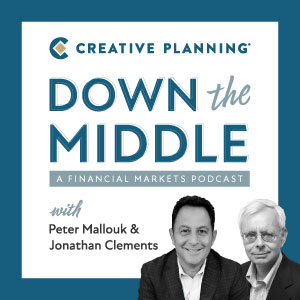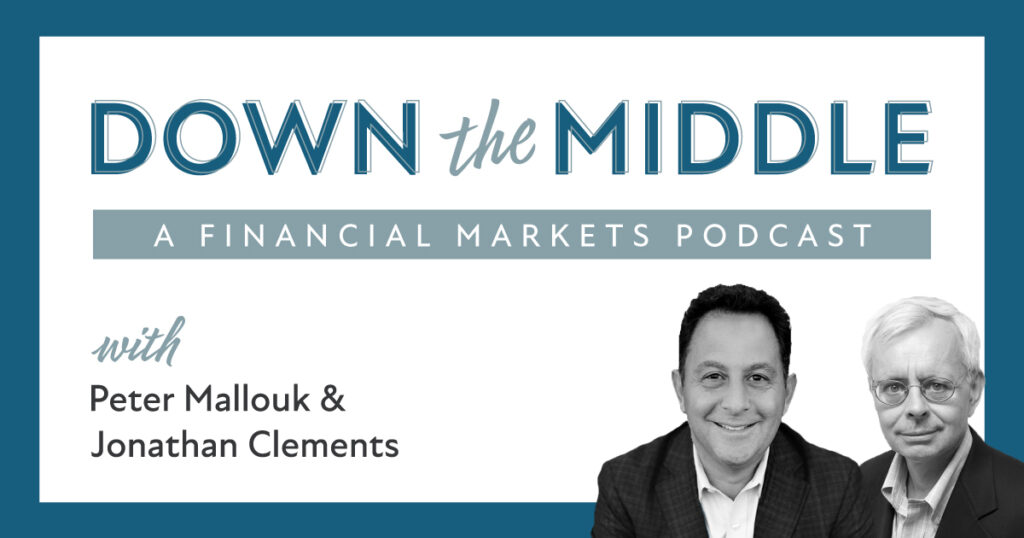Almost two years into the current stock market rally, worries over the economy, interest rates and this year’s presidential election have many investors feeling on edge. Peter and Jonathan give their take on why some investors have trouble sticking with their long-term asset allocation (and how media narratives contribute). Plus, learn why you should audit your cell phone app settings and consider clearing out your basement.
Hosted by Creative Planning’s Director of Financial Education, Jonathan Clements, and President, Peter Mallouk, this podcast takes a closer look into topics that affect investors. Included are in-depth discussions on financial planning issues, the economy and the markets. Plus, you won’t want to miss each of their monthly tips!
Transcript:
Jonathan Clements: This is Jonathan Clements, Director of Financial Education for Creative Planning. With me is Peter Mallouk, President of the firm, and we are Down the Middle. We’re almost two years into the current stock market rally and suddenly many investors are on edge. Is the economy slowing? How quickly will the Federal Reserve cut interest rates? Who will win the election, and what will it mean for the economy and the stock market?
Peter, as you and I both know, an investor’s best bet is to sell on a stock market allocation and then stick with it through thick and thin. And yet that’s easier said than done. For one reason or another, some investors become convinced that the market is going to plunge and they decide that they want far less of their money in stocks. Peter, why do some investors find it so hard to stick with their portfolio’s long-term asset allocation?
Peter Mallouk: Well, I think it’s because every single point of communication that they see on TV and on social media is working against them. And so if you think about when you watch TV on the financial media networks or basically any news network, their job’s not really to educate and inform. They get up every day, they’ve got an obligation to their shareholders. All of these businesses, for the most part, are publicly owned. They have a fiduciary duty to maximize returns for their shareholders, and the way they maximize the return for their shareholders is by selling ads. It doesn’t matter if you’re the Wall Street Journal or The New York Times, it doesn’t matter if you’re MSNBC or Fox, you’re selling ads. You’re in the business of selling ads. How do you get ads sold? You sell it on an eyeball basis. You’re telling people, “Here’s how many people are watching. Here’s how many people are listening.”
How do you get people to watch or listen? You have to alarm them. You have to create soap opera dramas. That’s why you see the news cycle is run now with narratives where it’s like a saga until a new narrative shows up. But there’s no incentive anywhere for any of these things, whether they’re financial media or just media in general, to be calming or reassuring or have you focus on the long run how things work out.
So we consume all this information to become more educated the way we do about everything else, the way an architect or an engineer or a doctor or lawyer, except when they can consume information, they become more educated. As a financial consumer, the more information you consume, the less likely you are to focus on the things that matter the most. And of course, you get all this information that things are going to be different and things are going to be bad and things are going to get changed for the worse. What are you going to do? It’s very American. Do one thing and that’s take action. Do something.
And really it should just be, “Hey, just sit there.” The smart investor should not be distracted by these things. Behavioral economics overrides almost everything else when it comes to the performance of a long-term investor. If you’re focused on the long run, if you’re focused on beating 90% of the people over decades, you’ve got to be really, really good at shrugging your shoulders at what you read and see.
Jonathan: And what you say is really important because it’s not just the narratives, but it’s how we as humans digest that information. Some of that information is going to make investors feel overly self-confident, and they’ll think, “Oh, I really know where the market’s going to head next and I’m going to bail out of stocks so I miss the upcoming decline.” For other people, it’ll be loss aversion that kicks in. It’s like, “I’ve made all this money over the past year. I really don’t want to give it up, and hence I’m going to get out of the stock market now before everybody else does.” So it’s not just those narratives, it’s the way it meets with our psychology and really messes with our heads.
So Peter, when you have somebody like that who’s convinced that they know the market’s going to fall and they want to make big changes to their current allocation to stocks, what do you say to try to keep them on track?
Peter: You know, I’ve had many, many of these conversations over my career, and these are much different than deciding what asset class someone should own or what return they need or what they should do with the charity because all those other things are less emotional? This is a very much emotional, psychological type of thing, and the market goes down one in four years. So one in four times, the client’s going to be right that the market’s going to go down.
I remember two conversations in my career distinctly, and one was when President Obama won and somebody thought the world was going to end and wanted to go to cash, and one when President Trump won and somebody thought the same. And in both cases, the market went straight up, right. Under Obama and Trump, you had this just record run up of the markets, which is what normally happens as the markets do very, very well.
But when someone presents a set of facts, the reality is that everything is always new. So you can never say, “Hey, we’ve seen this specific set of facts before.” Take the major market drops: 9/11, terrorist event, the tech bubble obviously related to overvaluations of the dotcoms, ’08-’09 was the mortgage crisis, and the most recent one was related to COVID healthcare. These are different narratives every time, but it’s like watching a horror movie. You have a different bad guy every time, but you generally know how the movie is going to end. There’s going to be a lot of blood and guts, but probably the main person’s going to survive, but then at the end of the movie, the bad guy, it turns out he’s alive and he’ll be back just like the next bear market is going to be back.
And that’s what makes it so difficult, because the set of facts, the storyline, is different every single time. But the overriding message though is, look, we’ve been through a lot of stuff as a nation, from the Kennedy assassination to the Vietnam War to the Iraq War to all of these different presidents and all of these policies and everything in between, and the reality is the cost of things has gone up over time. Earnings have continued to go up over time. People do come up with ideas that propel the economy forward. And if you have technology and innovation, that combined with people to buy things, you tend to see over the long run, not tend to see — have always seen — the market eventually rise. And so getting people to zoom out and be able to look at that is the key to being able to get through those moments in time.
Jonathan: I think the other thing that’s crucial is getting people to think about how long they can go without actually having to sell their stock portfolio. There are very few of us who would have any reason to sell all of our stocks tomorrow. And in fact, Peter, when I talk to folks, I say, “Well, any money that you plan to spend in the next five years should be out of the stock market and in nothing more adventurous than high quality short-term bonds.” Do you think five years is the right amount of time, Peter?
Peter: Yeah, I think you’re a hundred percent correct. And at Creative Planning, when we’re running a retirement projection with a client, we’re basically doing it to figure out, “How do we make sure for five years you’re covered?” Because we look at all those bear markets I talked about, they were all resolved much, much quicker than that, right? So we’ve got the income of the portfolio to live on, plus we have whatever other outside things are coming, whether it’s Social Security or rental income to live on. Then you’ve got bonds to go to if you must, then the stocks are there for longer than five or six years, and they’re there to offset a different risk, which is inflation. We have to preserve our purchasing power over the long run.
And so something each client of Creative goes through is figuring out, “Well, when are you going to retire? And let’s make sure those first five years are covered.” A lot of people will say, “Oh, Peter, I’m retired now. I can’t afford the risk of the stock market.” Well, if you’re retired and you’re 65, your life expectancy is 20 plus years. Your biggest risk is not that the stock market’s going to go up and down. The biggest risk is that your dollar will not retain its purchasing power, and to protect that purchasing power, you have to be an owner. You cannot just be a lender. You can’t just own bonds. You’re going to have to participate in this economy as an owner, which means the stock market.
Jonathan: I think another thing that people fail to focus on is what is the nature of the wealth that they have? Going back to what you said at the outset, Peter, we hear these scary narratives on social media and on television about the stock market, and it makes the stock market front and center in people’s mind. It’s like, “That’s my wealth and I can’t afford to see it disappear.”
But for most of us, when we add up how much we have in bonds and cash, how much our home and other real estate are worth, stocks as a portion of that is probably relatively small. If you really want to go broad, you can also think about the value of your human capital. You can think about any business that you have and what the value of that is.
When you put it all together, stocks as a piece of your overall wealth is probably relatively small, and the fact that the stock market might drop an average 35% in the bear market doesn’t mean that you’re going to lose 35% of your wealth. In fact, it may only turn out to be 10% or 15%, and, moreover, it’s going to be short-term. People just don’t take that broad view of their wealth.
So given all this, Peter, I have one last question before we get to the end of the podcast, which is this. We should, in theory, be able to figure out what our risk tolerance is ahead of time and settle on an asset allocation that reflects that, and yet this notion of assessing risk tolerance seems to be really messy, and oftentimes people get it totally wrong. Why is that?
Peter: I think basically it’s one thing to have a piece of paper that says, “I’m worried about this. I’m not worried about that.” It’s another thing to live through it. And even when you look at a chart of say, COVID, it looks like a blip. But you’ve got to remember minute by minute, hour by hour, day by day, it feels like an eternity.
Even ’08-’09, which seemed like it went on forever, it really went on from September of ’08 until March of ’09, but it felt like a decade because every day you’re getting hit and you’re getting hit and you’re getting hit. So it’s one thing for us to say, “Oh, for six months, anyone can get through that.” People go, “Of course, six months in my life, I can get through that.” But when it’s almost every day for 180 days you’re getting punched in the face, eventually, you want to move your head in a different direction.
It’s one thing to talk about it. It’s another thing to live through it. I always have a conversation with our clients around how they feel about risk after we’ve been through a bear market. I can really get a feeling for, “Hey, do you really have the ability? Were you unfazed? Were you excited because you could buy more, or were you losing sleep?” And that’s really the ultimate test of a risk tolerance.
Jonathan: Going back to 2008, you might remember there were many days the Dow dropped 500 points, and at the time the Dow was at around 10,000. And so I took saying to colleagues, “Well, another 10 days like this, losing 500 points and it’s all going to be over.” At the time, our gallows humor was not as funny as I thought it was. So anyway, Peter, it’s time for that part of the podcast. What is your tip of the month?
Peter: I think people don’t appreciate how much they’re lacking in privacy with their smartphones. And I would encourage everybody to go through an exercise that many of our clients are getting more serious about, and that is making sure that you are removing any apps that you’re not using. Turn off the tracking on any app. So many apps will default or ask to track everything that you’re doing or move into other services that you’re using. Remove the ability for them to do all of that.
Many apps will ask for access to your camera or your microphone. Remove the access to that. Secure your privacy. Don’t let these applications sell your information and use your information. Only allow the tracking for an app that’s related to maps or allow the camera for an app where you need to use that day to day. Otherwise, it’s too much of a reach. And do the best you can to protect yourself there. How about you, Jonathan?
Jonathan: So, Peter, as regular listeners will know, I’ve had this terminal cancer diagnosis, and as part of that, one of the things I’ve been trying to do is clear out the basement. I want to try to throw away as much stuff as possible so my family doesn’t have to do it after my death. And one, I’m just amazed at all the garbage I’ve kept going back 40 years, letters that I am never going to reread, school reports. I mean, you wouldn’t believe what I have down there, Peter.
But the other thing, and this is the point I really want people to hear, this is the fifth clearing out I’ve done in the last 11 years. Prior to this, I’ve moved four times, and each time I threw out stuff. And so this is my fifth clearing out that I’ve done of stuff that was once in the basement.
And I say this, hand on my heart, there is nothing that I have thrown away over the past 11 years that I would like to have back. There is nothing that has gone out, and believe me, it’s been a lot of stuff, and I have missed none of it. So I would encourage listeners, go down to the basement and start throwing out stuff. You will not regret it.
So that’s it for me, Peter, and that’s it for us. This is Jonathan Clements, Director of Financial Education for Creative Planning. I’ve been talking to Peter Mallouk, and we are Down the Middle.
Disclosure: This show is designed to be informational in nature and does not constitute investment advice. Different types of investments involve varying degrees of risk, and there can be no assurance that the future performance of any specific investment or investment strategy, including those discussed on this show, will be profitable or equal any historical performance levels.
Important Legal Disclosure:
creativeplanning.com/important-disclosure-information/
Have questions or topic suggestions?
Email us @ podcasts@creativeplanning.com





